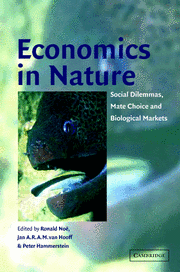Book contents
- Frontmatter
- Contents
- List of contributors
- Preface
- Acknowledgments
- 1 Games and markets: economic behaviour in humans and other animals
- Part I Economic behaviour in social networks
- 2 Social dilemmas and human behaviour
- 3 Cooperation and collective action in animal behaviour
- 4 Conflict, reconciliation and negotiation in non-human primates: the value of long-term relationships
- Part II Biological markets
- Part III Mating markets
- Index
3 - Cooperation and collective action in animal behaviour
Published online by Cambridge University Press: 04 August 2010
- Frontmatter
- Contents
- List of contributors
- Preface
- Acknowledgments
- 1 Games and markets: economic behaviour in humans and other animals
- Part I Economic behaviour in social networks
- 2 Social dilemmas and human behaviour
- 3 Cooperation and collective action in animal behaviour
- 4 Conflict, reconciliation and negotiation in non-human primates: the value of long-term relationships
- Part II Biological markets
- Part III Mating markets
- Index
Summary
Introduction
Models of cooperation in animal behaviour frequently address issues of cheating (also called defecting; reviewed in Dugatkin 1997). In the simplest case, cheaters gain more than cooperators because they obtain the benefits of another's action without paying the costs. Cooperation has been modelled extensively using two-player game theory models (especially the Prisoner's Dilemma; Axelrod 1984). However, these two-player models fail to capture the dynamics of cooperation in larger, polyadic social settings, which often require more complicated mathematical representations (n-player games; e.g. Joshi 1987; Boyd & Richerson 1988; Dugatkin 1990).
An empirical study by Heinsohn and Packer (1995) illustrates the difficulties of modelling cooperation in large social groups. These authors provide experimental evidence for cheating in lions by simulating territorial intrusions using playbacks. In their study, the perceived benefits of territorial defence were altered by playing back different numbers of roaring neighbours. The patterns of response suggest that female lions use one of four strategies: some females always participate (unconditional cooperators), others participate when they are most needed but not at other times (conditional cooperators), and some females never participate (unconditional laggards), or actually participate less when they are most needed (conditional laggards). Heinsohn and Packer (1995) examined whether some cooperative strategies commonly used in game theory might apply to lion cooperative territoriality (i.e. Tit-for-Tat and Pavlov; Axelrod & Hamilton 1981; Nowak & Sigmund 1993). However, these attempts were unsuccessful, probably because more complicated models are needed to represent the complex behavioural interactions expected with four strategies in a polyadic setting (Heinsohn & Packer 1995).
- Type
- Chapter
- Information
- Economics in NatureSocial Dilemmas, Mate Choice and Biological Markets, pp. 42 - 66Publisher: Cambridge University PressPrint publication year: 2001
- 30
- Cited by



